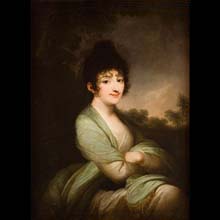
material: oil on canvas
dimensions: 90,5 x 69 cm
description: Michał Kleofas Ogiński (1765–1833) was a politician, émigré activist and composer. In 1789, he was awarded the Order of the White Eagle. He was often involved in the patriotic struggle for independence. After the fall of the Kościuszko Uprising, he stayed in exile. He played an important role, for example, in forming Polish legions in Italy. His most famous music pieces included polonaises: F major, known in Europe as “Ogiński’s polonaise” (1792), Pożegnanie Ojczyzny [Farewell to the Homeland] (1794) as well as Marsz dla Legionów [Song of the Polish Legions in Italy, the current national anthem of Poland, which he sent to General Józef Dąbrowski (1797). In 1789, he married Izabela, née Lasocka, (1764–1852). They had two sons. A long, lonely stay in exile after the Kościuszko Uprising caused family problems and led to a divorce after his return home around 1798. The portraits of the Ogiński couple are typical examples of works by Józef Grassi. The painter slightly idealized facial features, conveyed the subtle elements of female beauty, made eyes look bigger and gave them the look of reverie and melancholy. He portrayed men in a similar way. Drawing on English portraiture, Grassi painted his sitters against a landscape. The aim of the conservation of the painting in 2009–2010 is to reveal the original appearance of the figure, hidden up to then, as the painting was painted over by an unknown artist. Barbara Ciciora
exposition: The Gallery of 19th Century Polish Art in Sukiennice,
The Cloth Hall, 1, Main Market Square
key: Enlightenment >>>
dimensions: 90,5 x 69 cm
description: Michał Kleofas Ogiński (1765–1833) was a politician, émigré activist and composer. In 1789, he was awarded the Order of the White Eagle. He was often involved in the patriotic struggle for independence. After the fall of the Kościuszko Uprising, he stayed in exile. He played an important role, for example, in forming Polish legions in Italy. His most famous music pieces included polonaises: F major, known in Europe as “Ogiński’s polonaise” (1792), Pożegnanie Ojczyzny [Farewell to the Homeland] (1794) as well as Marsz dla Legionów [Song of the Polish Legions in Italy, the current national anthem of Poland, which he sent to General Józef Dąbrowski (1797). In 1789, he married Izabela, née Lasocka, (1764–1852). They had two sons. A long, lonely stay in exile after the Kościuszko Uprising caused family problems and led to a divorce after his return home around 1798. The portraits of the Ogiński couple are typical examples of works by Józef Grassi. The painter slightly idealized facial features, conveyed the subtle elements of female beauty, made eyes look bigger and gave them the look of reverie and melancholy. He portrayed men in a similar way. Drawing on English portraiture, Grassi painted his sitters against a landscape. The aim of the conservation of the painting in 2009–2010 is to reveal the original appearance of the figure, hidden up to then, as the painting was painted over by an unknown artist. Barbara Ciciora
exposition: The Gallery of 19th Century Polish Art in Sukiennice,
The Cloth Hall, 1, Main Market Square
key: Enlightenment >>>












